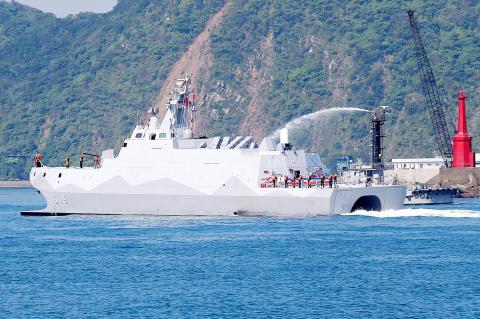The nation’s new stealth missile corvette, the Tuo Jiang (沱江), began its service yesterday.
Minister of National Defense Yen Ming (嚴明) presided over the ship commissioning ceremony at Suao Port in Yilan County.
The 500-tonne corvette was handed over by its builder Lung Teh Shipbuilding Co to the Republic of China Navy yesterday morning after undergoing performance testing and sea trials in recent weeks.

Photo: CNA
Yen touted the newly commissioned vessel as “currently the fastest warship in Asia and possessing the most firepower.”
“The ship’s commissioning today marks a milestone in the Republic of China Navy’s efforts to enhance its combat capabilities and modernize its fleet,” he said.
Yen said the program is a model of success for the military’s domestic warship-building policy, since the Tuo Jiang is a wholly indigenous production, from its concept and design to its manufacturing.

Photo: Chien Jung-Fong, Taipei Times
The ship’s captain, Lieutenant Commander Wang Te-jean (王得?), affirmed the corvette’s reputation as a first-rate littoral combat warship.
“It is the navy’s aircraft-carrier killer. With speed, good mobility and stealth technology, the corvette can get close to its target before launching a missile attack,” Wang said.
The vessel can carry 16 Hsiung Feng II and Hsiung Feng III anti-ship supersonic missiles.
According to its original design, the corvette has a maximum speed of 38 knots (70.4kph), but it was able to reach 44 knots during the sea trials, Wang said.
Its advanced electronics system allows the captain to direct the vessel without having to remain on the bridge, he added.
The corvette is outfitted with an Otobreda 76mm gun, four 12.7mm machine guns, an MK15 Phalanx close-in weapons system and three MK32 torpedo launchers each on the port side and the starboard sides.
The Tuo Jiang has a twin-hulled catamaran design with a combination of tilted angles and flat surfaces to give it a low observation profile, along with the use of radar-absorbent materials with other advanced stealth technologies to reduce its visibility to radar detection and tracking.
“It has two MTU V16 diesel engines that power a water-jet propulsion system, which enables the ship to sprint high in the water at high velocities, even in rough conditions,” navy spokesman Vice Admiral Wen Cheng-kuo (聞振國) said, adding that it has a range of 2,000 nautical miles (3,704km).
Following the handover, the navy is to begin training personnel to familiarize them with the craft, which is based at the port in Suao Township (蘇澳).
The vessel cost about NT$2.1 billion (US$66.39 million), and the navy has plans to commission eight to 12 of the corvettes, depending on budget funding.
Lung Teh began construction of the Tuo Jiang in late 2012.
Huang lauded the navy’s efforts to work with local shipbuilding companies.
In a symbolic gesture, Lung Teh chairman Huang Shou-chen (黃守真) handed over a miniature model of the corvette to Yen.
The 60.4m-long, 14m-wide vessel is patterned after Independence-class LCS (littoral combat ships) produced by the US that are designed to operate mostly in coastal zones.
Additional reporting by CNA

US climber Alex Honnold is to attempt to scale Taipei 101 without a rope and harness in a live Netflix special on Jan. 24, the streaming platform announced on Wednesday. Accounting for the time difference, the two-hour broadcast of Honnold’s climb, called Skyscraper Live, is to air on Jan. 23 in the US, Netflix said in a statement. Honnold, 40, was the first person ever to free solo climb the 900m El Capitan rock formation in Yosemite National Park — a feat that was recorded and later made into the 2018 documentary film Free Solo. Netflix previewed Skyscraper Live in October, after videos

Starting on Jan. 1, YouBike riders must have insurance to use the service, and a six-month trial of NT$5 coupons under certain conditions would be implemented to balance bike shortages, a joint statement from transportation departments across Taipei, New Taipei City and Taoyuan announced yesterday. The rental bike system operator said that coupons would be offered to riders to rent bikes from full stations, for riders who take out an electric-assisted bike from a full station, and for riders who return a bike to an empty station. All riders with YouBike accounts are automatically eligible for the program, and each membership account

A classified Pentagon-produced, multiyear assessment — the Overmatch brief — highlighted unreported Chinese capabilities to destroy US military assets and identified US supply chain choke points, painting a disturbing picture of waning US military might, a New York Times editorial published on Monday said. US Secretary of Defense Pete Hegseth’s comments in November last year that “we lose every time” in Pentagon-conducted war games pitting the US against China further highlighted the uncertainty about the US’ capability to intervene in the event of a Chinese invasion of Taiwan. “It shows the Pentagon’s overreliance on expensive, vulnerable weapons as adversaries field cheap, technologically

NUMBERs IMBALANCE: More than 4 million Taiwanese have visited China this year, while only about half a million Chinese have visited here Beijing has yet to respond to Taiwan’s requests for negotiation over matters related to the recovery of cross-strait tourism, the Tourism Administration said yesterday. Taiwan’s tourism authority issued the statement after Chinese-language daily the China Times reported yesterday that the government’s policy of banning group tours to China does not stop Taiwanese from visiting the country. As of October, more than 4.2 million had traveled to China this year, exceeding last year. Beijing estimated the number of Taiwanese tourists in China could reach 4.5 million this year. By contrast, only 500,000 Chinese tourists are expected in Taiwan, the report said. The report